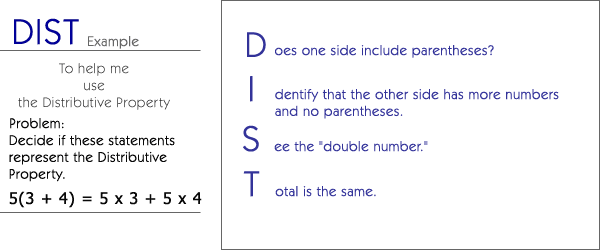 |
|
|||||
|
|
|
|
|
|
|
|
| |
|
|
||||

D oes
one side of the equals sign include parentheses?
-
Highlight all the parentheses in all the equations.
" I have highlighted the parentheses in both of the equations. There are parentheses on one side of the equation."
I
dentify that the other side has more
numbers and no parentheses.
-
Count the numbers on each side of the equation. If you need to, make tally marks under each equation to help you keep track of the how many numbers you have counted.
"If 5(3 + 4) has parentheses, then the other side the equation should not have any parentheses and it should have more numbers. I know that it has no parentheses, because there are no parentheses highlighted. Now I need to count the numbers on each side of the equation. The left side has a 5, a 3 and a 4. The left side has three numbers. The right side has a 5, a 3, another 5, and a 4. 1,2,3,4. The right side has four numbers. So it has more numbers and no parentheses."

S ee
the "double number."
-
Find the side with the parentheses. Find and circle the number outside of the parentheses. Look at the other side of the equation. The number you circled should be written twice on the other side of the equation. Find and circle the double number.
"Now I need to look for the double number. First I am going to look for the side with the parentheses. The number 5 is outside of the parentheses. I am going to circle it. There should be two 5's on the other side of the equation. There is one 5 here that I am going to circle, and one here. So 5 is outside of the parentheses on the left side of the equation, and written twice on the right side."
T otal is the same.
-
Solve each side of the equation to see if the total is the same on both sides.
"When I solve 5 (3 + 4) I get 35 because 3 + 4 is 7 and 7 times 5 is 35. That is the same answer I get when I solve 5 x 3 + 5 x 4 , because 5 x 3 is 15 and 5 x 4 is 20, and 15 plus 20 is 35. These two mathematical statements are examples of the Distributive Property."
| |
|
|
|
|
|
|
|
| |
 |
||||||
|
|
|
||||||
| |
|
||||||
| |
|
|
|
|
|||
| |
|
|
|||||